
Tips for Choosing the Right Ground Cover
Do you have areas in your yard where nothing seems to grow properly? You've tried annuals and flowering perennials. You've planted shrubs. You've attempted to cover the ground with grass, and even that failed. Not to worry. There is a groundcover that'll work no matter if your problem is sun, shade, dampness or dryness. You just need some tips on choosing the right groundcover plants.
Some call groundcovers the Energizer Bunnies of plants. Once settled in, happily located groundcovers prosper for decades with little care or maintenance. They keep on going and going. Their only drawback is some groundcover species are too aggressive and need occasional cutting back. That's not too much to ask considering how low your initial investment is.
The best groundcover plants are the ones placed in the right spot. Groundcovers aren't much different from other vegetation. They need hardiness to suit your climatic zone or microclimate. You need to select plants for the available amount of light and provide them with proper soil conditions. And knowing how to pick a groundcover plant that will survive trouble-free includes buying it from the right grower.
Plant longevity starts with excellent genetic stock. Sure, you might luck out and pick up discount groundcovers at big-box retailers. They have some attractive blowout pricing. But remember, you always get what you pay for, and that holds true with groundcover plants. The key to good plant health is finding the right nursery. Look for one that has the time and knowledge to help you select exactly what you need to cover the ground in your area.
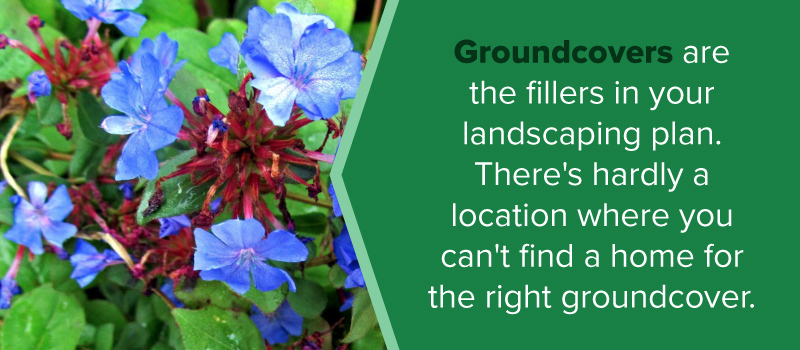
Benefits of Groundcover Plants
What's not to like about groundcover plants? They produce so many benefits for so little effort. Groundcovers are the fillers in your landscaping plan. There's hardly a location where you can't find a home for the right groundcover. And if you put them in the right space, they'll continue to benefit your yard for years. Here are the main benefits you'll get from choosing the right groundcover plants:
- Groundcovers are perennial. Some are evergreen and stay visible all year round no matter what your climate zone is. Others, like ornamental grasses, appear to die off in the fall but eagerly reappear spring after spring. Each year groundcovers prosperously fill your landscape with texture, fragrance and vibrant hues of variegated color.
- Groundcovers are low maintenance. Once your groundcover plants establish, there’s minimal maintenance required. You might have to cut back fast-growing groundcovers like English Ivy, but most others tend to look after themselves. The right species need minimal watering and once a groundcover is mature, weeds can barely compete.
- Groundcovers are economical. Juvenile groundcover plants are not expensive. In fact, groundcovers provide the best return on investment considering their initial low cost and how fast they fill in their sites. The secret is to buy healthy specimens and then space them far enough apart that each plant room to expand.
- Groundcovers are versatile. No matter what light, soil or water conditions your yard offers, you're sure to find a versatile species that suits it. Groundcovers have a multitude of leaf textures and colors. Some produce flowers, and some provide berries.
- Groundcovers prevent erosion. They're perfect for sloped sights where soil erodes from water runoff. Groundcovers also help with open, exposed places where soil dries and is blown away by the wind. The right groundcovers have deep root systems anchoring themselves to the earth and preventing harmful erosion.
- Groundcovers provide wildlife habitat. Thick groundcover foliage hosts beneficial insects like ladybugs and lacewings. Flowering groundcovers give nectar and nutrient to pollinating bees. And berries from groundcovers serve as food for birds. Small critters also find shelter below groundcover canopies.
- Groundcovers are eco-friendly. They're living plant masses. Some groundcovers expand over vast areas and grow to climb rock faces and fence lines. These are living mini-ecological systems that filter carbon dioxide and replace it with oxygenated air. They also scrub out pollutants.
The best benefit of groundcovers is the enormous variety available to choose from. There are dozens and dozens of groundcover species. That includes subspecies carefully crafted for specific conditions. Let’s look at what groundcover options you have and then move on to tips on selecting and planting your groundcovers.
Goundcover Options
Contact Garden Goods Direct for the highest quality plants at the best possible prices. We ship groundcover plants as well as shrubs, trees, and perennials all over America. Our excellent line of groundcovers includes English Ivy, Geranium and Liriope plants. Proven performers include:
- Ajuga Bronze Beauty (Ajuga reptans)
- Carex Blue Zinger
- English Ivy (Hedera helix)
- Geranium Biokovo
- Geranium Karmina
- Geranium Max Frei
- Golden Japanese Forest Grass (Hakonechloa m. ‘Aureola’)
- Pachysandra terminalis (Spurge)
- Periwinkle (Vinca minor)
- Variegated Liriope (Liriope muscari)
How to Choose a Groundcover Plant
Inexperienced gardeners can find choosing the right groundcover challenging. But, it doesn't have to be overwhelming. There's plenty of information available on the internet. However, you need to be a bit careful. The most significant consideration when choosing plants is the habitat you plan to set them in. Then there's the appearance you're looking for.
One big tip is to get professional advice. Contact our customer support team so our trained staff to help you out. These knowledgeable folks have the experience to know what specific types of groundcover work well in your local area. They may also assess your site location and suggest what to plant and where to plant it.
This simple approach will save you time and money. It'll also save you the frustration of buying plants not suited to your landscape plan. Professional nursery workers know what works best in sunny areas as well as shaded sites. They also know what to avoid, and this can be of enormous benefit to you. Here are the factors professional gardeners use to choose the right groundcover plants.
Zone Hardiness
The first thing your nursery adviser will ask is what climatic zone you're gardening in. The United States Department of Agriculture (USDA) carefully divides all 50 States as well as protective territories into eleven separate climatic zones. They range from one to 13.
The lowest number is one. Almost nothing grows in zone one due to permanent frost conditions on the ground or ambient air temperatures that never warm sufficiently enough to promote photosynthesis. The soil is also too cold to transmit liquid water and essential nutrients.
Places in zone 11 will accommodate most natural and commercially available groundcover plants. Zone 11 is the mainland country's warmest region where frost is practically unheard of and night air temperatures seldom dip below 40 degrees Fahrenheit. A word of caution, though. Some groundcover plants won't tolerate excessive heat and humidity just like warm climate plants won't take the cold. It's best to contact a nursery and discuss specific plants before purchasing.
Most climate zones in America range between four and eight. That's a sweet spot for groundcovers as most species like cool earth and moderate air. Remember, groundcovers are perennial, permanent plants that need to survive over winter. Your zone rating takes in an extreme range of temperatures, both hot and cold. To help find your climatic zone, visit the USDA Plant Hardiness Zone Map and enter your zip code. You'll need to know your zoning before opening an informative dialogue with your nursery representative.

Err on Caution’s Side
Another tip you'll get right from your nursery is to err on the side of caution when choosing groundcover plants for hardiness. A zone eight rating doesn't guarantee survival in warm southern or coastal regions. There are microclimates in each zone that vary above and below average temperatures. Microclimates even occur within your yard. Sunny, south-facing places with building backdrops will take a less hardy plant than exposed north-facing positions.
A rule of thumb is selecting groundcover plants rated to survive in one to two zones below your location. For instance, if your zip code falls in zone eight, it's wise to choose groundcover plants rated for six or seven. You can't go wrong with that. Think of it as insurance against losing your new plants the first season when an unexpected dip sends them into unrecoverable shock.
The same goes for groundcover plants destined for hot, dry locations like the arid Southwest. Excessive heat and lack of water will quickly kill high zone rated plants that do well in humid, subtropical places. Like real estate, selecting groundcover plants starts with location, location, location. This is where your friends at a top-quality garden supply store are invaluable.
Specific Growing Conditions
Once you've identified your plant hardiness zone, the next thing your nursey rep will ask is what specific growing conditions you have. They'll drill deeper on the location issue to help you choose the best groundcovers. Primarily, they'll want to understand these five factors:
- Sun conditions
- Shade conditions
- Soil conditions
- Slope conditions
- Moisture conditions
These five conditions encompass what's necessary to consider in selecting groundcover plants that go beyond mere survival. If they're suitably selected, the right groundcover plants will deliver every benefit we've already discussed. Let's start with sun conditions.
Ground covers fall into two groups. One is sun-tolerant plants. The other is shade-loving species. Sun tolerant plants vary in placement. Some are suitable for all day, full sun from daybreak to dusk. Ornamental grasses are good examples of full-sun plants. Some are even drought tolerant and bask away no matter what's thrown at them. Other sun-tolerant ground covers are fine with half-day exposure. That can be all morning, midday or only the afternoon and evening.
Shade tolerant groundcover plants are more delicate. They don't do well with full exposure as too much direct sunlight burns their leaves and dries them out. Most shady groundcovers can stand full sun for a while but prefer lower direct light for most of the day. Using a rule of thumb, any more than a half day's sun exposure is too much for groundcovers rated as shade tolerant. Excellent shady groundcovers include Hostas.
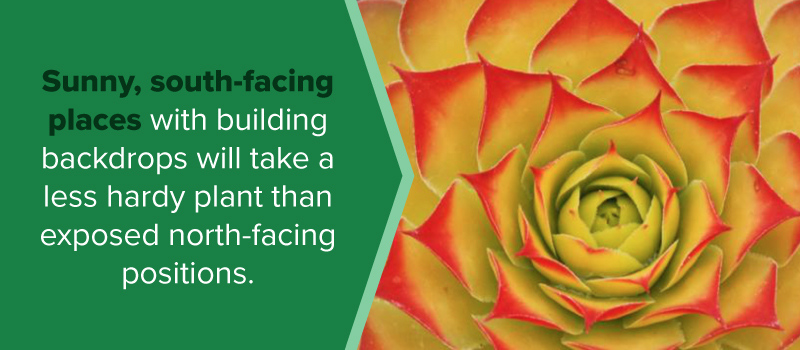
Know Your Soil’s pH Level
Soil conditions are critical to both sun and shade groundcovers. You can categorize soils as either alkaline or acidic, or sweet and sour in the dirt business. You first measure soil conditions by their pH level. That's short for potential of hydrogen, and it's critical to plant life. The scale goes from one to 10 with alkaline conditions being low pH scores from three to five. Acidic soil ratings are high and range from six to eight. A neutral pH level in garden soil is five to six.
Going back to rules of thumb, most sun-tolerant groundcovers do well in neutral pH soil. Shady species prefer a slightly higher number with acidic conditions of six to seven. Your nursery plant specialist will likely ask what pH levels you have where you intend to cover the ground. They'll recommend the right plants or recommend how you can adjust your soil to get to the right pH level.
Slope conditions are also a crucial factor in choosing the best groundcover. Steep slope conditions suit some species better than flat, level sites. Two things occur on sloped sites. One is erosion where the right groundcover can work miracles in prevention. Plants with extensive root systems are best for slopes. The other is drainage. Most sloped sights drain faster than depressions. Your slopes-site groundcover plants need less water than flat landers
Moisture is the source of all life. Without water, no plant will survive no matter what sun, shade, soil or slope conditions you have. But nature knows this and allows many plant species to thrive with very little moisture while others do fine in wet, soggy soil. Some groundcovers are highly drought resistant. They stand up well in sunny and rocky locations. Others need constant water and work well where it's wet. Again, your nursery specialist will know this. They'll help you choose the right groundcover plants.
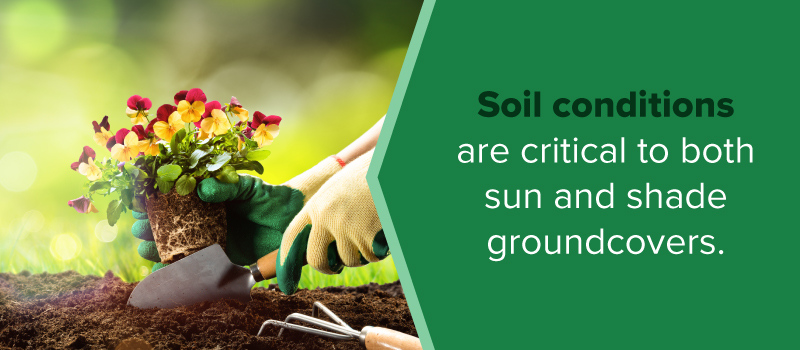
Groundcover Size, Texture and Appearance
There are three more bits of information your garden supply center specialist will ask for — what size of groundcover, what appearance and what texture you want. All three factor into aesthetic value. After all, you want your groundcover plants to look great over the years as well as provide top-notch performance.
Some groundcovers are slow growing. Others take off like a shot. You'll likely want a balance where your groundcover plants anchor quickly and spread out. But, you don't want them to become overwhelming and require extensive maintenance. Growing conditions have a significant influence on how big your plants become. The other factor is choosing the correct species.
Experienced gardeners plan for plant expansion. They know their particular species and what the expected mature size will be. They also plan their original planting spaces with just the right number of individuals, so they work in conjunction. Proper spacing is critical to getting a quick effect from new plants but still keep them from overpowering each other.
Landscapers often group groundcovers by size, taking into account the amount of creep or free range of each plant, as well as the height of a mature plant. Some groundcovers stay low and go far. Others are bushy and expand upward to fill in under shrubs. And then there are the climbers growing right up the sides of buildings and into tree limbs. These plants can be overpowering if left uncontrolled.
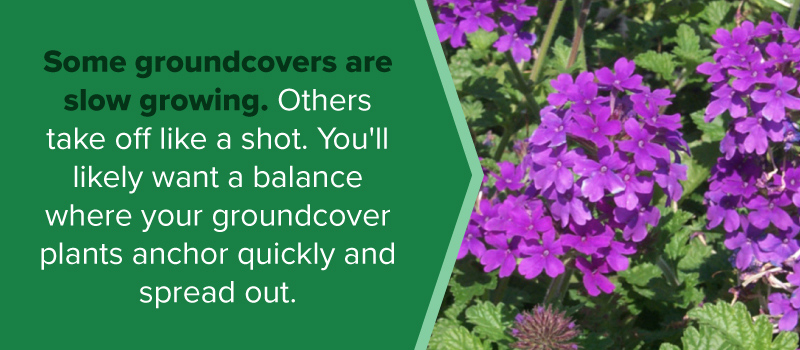
Dividing Groundcovers
Something to keep in mind when picking groundcovers by size is that they can be divided. Because groundcovers are perennial plants, they can be separated and broken into new planting groups. This saves a lot of money that you would have to spend on new plants to fill in other landscape areas.
Dividing groundcover plants is easy, but there are several things to know. A fundamental dividing principle is to separate spring flowering plants in the fall and fall flowering groundcovers in the spring. You can divide and transplant perennials any time of year, but early spring and late fall are best. Avoid the mid-summer heat as this puts stress on freshly severed root systems.
Texture is critical for choosing the right groundcover plants. Some plants have bold foliage. Others have fine, delicate leaves. Much of this is a personal choice but you can use groundcover plant texture to your advantage. Spiky leaves and thorny stalks are excellent covers where you want to deter traffic. Smooth, silky plants have a softer appeal. They're best suited for statements where you want an eye-catching draw.
Color is another primary aspect of groundcover appearance. There's a rainbow plethora available that ranges from bright green glows to soft, shady hues. Many groundcovers sport seasonal flowers while others boast colorful berries. Deciduous groundcovers turn into blazes of golds and reds come the fall while evergreens keep their green color year round.
For best appearance, your ground cover choices should include a careful blend of texture and color. You can use your creativity in this area as long as your plant selection meets your hardiness zone and your specific site conditions.

Preparing Soil for Planting Groundcovers
Once you've picked out your groundcover plants, do them and yourself a big favor. Make sure your ground is prepared for planting. We discussed soil pH and how important it is. You can easily test your pH level by purchasing an inexpensive soil test kit.
This will give you a reasonable working idea of whether you're on the sweet or sour level. Research your particular ground cover pH requirement and then adjust or amend your soil accordingly. It's much easier to bring acid soil down on the scale than to correct alkaline conditions. You can control high-acid soil by adding lime or bone meal. Alkaline soil often requires a more complicated, chemical approach.
Both conditions benefit from a rich addition of organic mulch. You can make compost or buy pre-composted mulch from your garden supply house. Most organic mulches contain critical nutrients and trace elements, including the big three fertilizer components of nitrogen (N), potassium (P) and phosphorous (K). Other vital nutrients include iron, magnesium, calcium, sodium, chlorine, copper and zinc.
Determining your soil's nutrient content requires a proper laboratory test. It's a bit of an expense, but it's the only way to be sure about the quality of your soil. Once you know, you can make adjustments. It's worth the time and cost if you want ultimate performance from your groundcover plants.
Planting Groundcovers
Groundcover plants require the same planting care as other additions to your landscape. They need prepared soil, mulch, fertilizer, water and protection from heat for the first few days while they settle in. Plan your planting around a cooler time, probably spring or fall unless you're able to predict a cloudy stretch.
Heat puts plants into distress, especially if hit by a dry spell. Make sure you pre-soak your soil and keep it continually wet for the first few weeks after planting. Also, make sure your planting fertilizer is higher in potassium and phosphorous than nitrogen. This promotes root growth rather than leaf vegetation growth.
Plant spacing and sequencing are also vital, particularly so if you're planting on slopes. The best arrangement isn't consistent rows. You should stagger groundcover plants so that each plant offsets the others. That way you'll have a more random pattern. Ultimately, your mature groundcover plants will spread out evenly and look exactly like they're supposed to, like a blanket of plants covering the ground
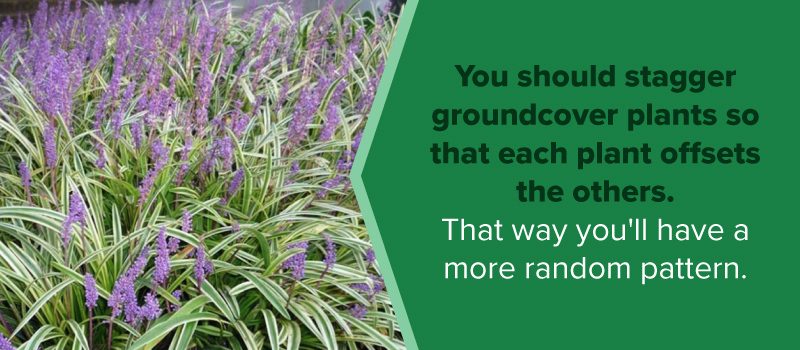
At Garden Goods Direct, customer satisfaction is our ultimate goal. And we're not just the grower-direct plant store providing groundcover plants to all hardiness zones across America. We're your complete garden supply store with everything you need to grow and accessorize your yard.
Shop our supply of plants and purchase groundcover plants online. We pride ourselves on personally helping you. Contact Garden Goods Direct today to speak to a gardening expert about your groundcover planting needs.

